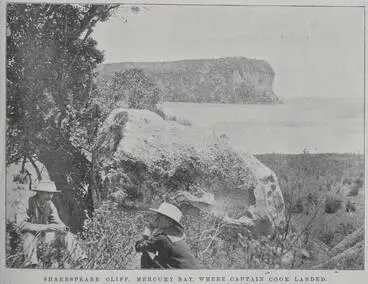Te Horeta Te Taniwha and his nail
A DigitalNZ Story by National Library Services to Schools
When Te Horeta Taniwha was a boy he came on board the Endeavour when it visited Mercury Bay In 1769. There he met Captain Cook who gave him a nail.
These resources and text relate to Te Horeta Taniwha (Ngāti Whanaunga) who, as a boy, was given a nail by Captain Cook. They have been sourced and collated from DigitalNZ and other websites.
Whao (chisel)
Museum of New Zealand Te Papa Tongarewa
Background
This ship’s nail has been adapted and used in the past as a small toki (chisel) for wood carving. In 1852 an elderly Te Horeta Taniwha narrated for the written record his boyhood encounter with Captain, James Cook, when the Endeavour visited Mercury Bay in November 1769. Cook gave Te Horeta a ship’s nail and Te Horeta said he "used it for many things." In fact, it was so precious he referred to it as his atua or god.
B. The Account of Cook's Visit By Te Horeta Taniwha - The Discovery of New Zealand
Victoria University of Wellington
Te Horetā
Manatū Taonga, the Ministry for Culture and Heritage
Context
Te Horeta was a respected leader of Ngāti Whanaunga, one of the Marutūahu confederation of Hauraki Gulf and Coromandel Peninsula iwi. He may have been born about 1757, for he told Captain James Cook he was aged about 12 when he met him.
Sailing ship nails were used by early European Pacific explorers to trade for goods and services from indigenous peoples. Nails were initially highly prized by Māori. Before their first encounters with Europeans they had no metal tools, weapons or implements, only stone. Large ship nails were more adaptable and versatile than stone tools and could be used as chisels, drills and weapons tips.
Patu pora (iron hand club)
Museum of New Zealand Te Papa Tongarewa
Quick facts
- Te Horeta received the name Taniwha during a battle. He dived into a river and climbed into a waka and killed 7 warriors. Te Horeta's people thought the feat was that of a taniwha.
- In 1767, the British frigate Dolphin was the first European ship to discover Tahiti. The Dolphin’s sailors used nails and hooks to trade with the Tahitians. So many hooks and nails were pulled out of the ship that it was in danger of falling apart!
- Cook traded or bartered with indigenous peoples using items like beads, nails, cloth, ribbons, iron knives and even potatoes.
Arched rock, Mercury Bay
Manatū Taonga, the Ministry for Culture and Heritage
Artist unknown :Mercury Bay, New Zealand. - [ca 1840]
Alexander Turnbull Library
Other resources
Captain James Cook — explore the stories, art and maps of Cook’s voyages.
Captain James Cook— Kei tēnei pae tukutuku tētahi o tā Kāpene Kuki kōrero haurongo.
Find out about the Endeavour — what did the inside of the Endeavour look like?
James Cook in the Coromandel — looks at what happened to the Endeavour and crew while anchored in Cook’s Beach.
Maori powhiri — welcome onto the Marae.
Ngāti Whanaunga — a video of the history of the Ngāti Whanaunga people from Coromandel.
Pursuit of Venus: Infected — Lisa Reihana’s artwork video looks at the story of first encounters between Polynesians and Europeans.
Te Horeta’s nail by Janet McCallum, School Journal Part 2 No 1, 1997. Year 4.
Te Takiby Ben Brown, School Journal Part 4 No 3, 2009. Year 6.
Waka man — Alby Waititi discovers people who are passionate about waka and their traditions.
Māori treasures in European museums — Māori view taonga (treasures) as their ancestors, therefore how they are presented and treated in museums is very important.
Ngā taonga ki ngā whare taonga o Ūropi— Ki tā te Māori he tipuna te taonga. He mea nui te tiaki taonga.
Te Horeta — He haurongo kōrero e pā ana ki Te Horeta
Te Papa Tongarewa - Wahanga Rangahau Taonga Māori — Nā Te Papa Tongarewa tēnei pae tukutuku. Kei konei ngā whakairinga rangitaki me ngā korero e pā ana ki ngā taonga Māori kua rangahautia e Te Papa Tongarewa.
[Te Horeta Taniwha. 185-] - Selected Images from the Collections of the Alexander Turnbull Library
Victoria University of Wellington
DEATH OF THE CELEBRATED NATIVE CHIEF HOOK-NOSE. (Communicated.) (Daily Southern Cross, 06 December 1853)
National Library of New Zealand
Fertile questions
- What makes objects precious?
- Are we more the same than different?
- Why do we give gifts?
- He aha te koha?
- Mā te aha e taonga ai tētahi mea?
- How and why do people use materials in different ways?
- What is your question?
Additional questions
- Does technology change our lives for better?
Mercury Bay natives in their canoes greet Captain Cook upon his arrival. (Evening Post, 23 December 1939)
National Library of New Zealand
Shakespeare Cliff, Mercury Bay, where Captain Cook Landed
Auckland Libraries
Cooks Beach, Coromandel Peninsula
Alexander Turnbull Library
Mercury Bay. Cook's Watering Place, where he landed and found fresh water, and first unfurled the British Colours and claimed New Zealand.
Auckland War Memorial Museum Tāmaki Paenga Hira
This story was compiled and curated by Te Puna Mātauranga o Aotearoa | National Library of New Zealand, Services to Schools staff, in 2019.




